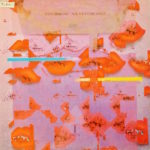
Six years after our first introduction to Joan Bibiloni, via his fantastic debut (Joana Lluna), the world had moved under him. For A Future Smile presented Joan Bibiloni in a way unlike anything before. Just a year earlier Joan had been commissioned by a Spanish TV network to create a soundtrack for a nature documentary. That release came to be known as Silencio Roto. Silencio Roto found Joan toying with a more ethereal kind of Balearic music. Its mix of moody, synthesized soundscapes and languid guitar arrangements tied it closer to ambient music than his earlier, more heavily jazz, funk, and prog-indebted music.

Joan had already made great strides in presenting the mediterranean music of Mallorca as something easily relatable in other Blau releases but Silencio Roto presented it in abstraction, with mystery. Silencio Roto was what the sound of those Balearic islands could potentially be. One year later, For A Future Smile knowingly took it one step further.
The giant English record label Polygram was interested in cashing in on the New Age craze. Using a subsidiary they’d dub Theta, Polygram rounded up a few artists like Steve Parsons, Scarlett Rivera, and Stephen Russell. What they were missing, though, was a star. Originally, someone in Theta stumbled upon Silencio Roto on TV and realized there was something unique there. Joan Bibiloni was contacted, afforded a three year contract, and pitched to the idea of using that album as his English/worldwide debut. Joan, wary of repeating himself, instead shared with them new compositions written entirely as demos using only drum machines and synths he had in his studio. Those fledgling compositions came to be fleshed out in what became For A Future Smile.
Joan had scarcely an idea of what New Age meant but he knew enough to actually use that label to his own benefit. For sure, he didn’t want to create anymore jazz fusion. Theta wanted easy listening instrumental music and Joan instead gave them what new explorations he had been crafting. As he revealed in Spanish interviews, Joan felt moved by the music of ECM and more minimal music tracking around his shores. What he didn’t want to do was create “New Age” as the label aspired him to, one full of pretension and noodling tedium. Joan wanted to really go “out” there – make something that moved you.
Using tape delay systems, sonic harmonizers, tracking drum machines, overdubbing synth and guitar parts, For A Future Smile was a refinement of everything he’d ever done before. Less meandering and more defined, well thought out, on this release Joan was forcing himself to really zero in on what was unique to his style and locale.
Personally, this is why I enjoy For A Future Smile the most, out of all his releases. If anyone can believe the myth, this was the album where the myth-making truly began. Never again would you find Joan as in control of the full scope of his talent, as he was here. Lately, whenever I play his album, usually in the morning, and I hear those first arpeggiating guitar lines of “Montenegro 8” my whole countenance just eases into the day. There is this overwhelming feeling of peaceful rumination that carries right through the album. For every intriguing sonic interplay, there is an equal zen-like, soft musical movement. By the time you’ve gotten through “After The Jungle”, “Val, I Vuw Ya”, “Ay, Ay, Ay” and all tracks in the between and thereafter, whatever darkness there was within you seems to evaporate – so strong is the easy, breezy power of For A Future Smile. There are even those times when Joan gives you faint vocalizations, as if too sensitive to us to ruin the greater mood. These are the tender, beautiful, human things that you tend to remember when you hear tracks like “Val, I Vuw Ya”, especially.
Is there such a thing as a late, late summer? If you believe Joan, there never seems to be anything but that, there, in Majorca.
